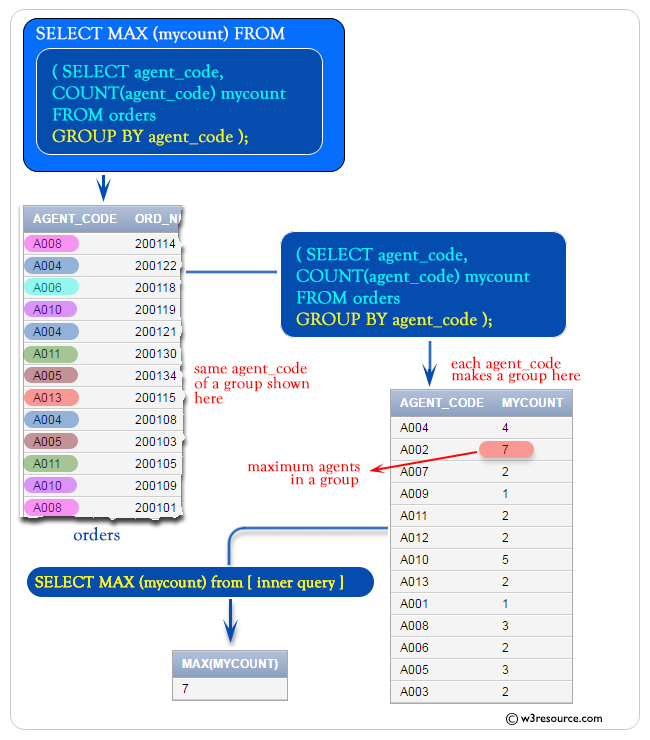

How can I create another query that lists the Type, Color, and Location for each distinct Type,Color when the count of unique locations for that Type,Color is greater than 1? The resulting recordset would look like: Type Color Location

GROUP BY Type, Color HAVING Count(Location)>1 The function also returns NULL if expr is NULL. If there are no matching rows, AVG () returns NULL. (SELECT DISTINCT Type, Color, Location FROM MyTable) The DISTINCT option can be used to return the average of the distinct values of expr.
#Mysql count distinct group by how to#
I'm using: SELECT Type, Color, Count(Location) FROM To answer your immediate question, how to count rows of a subquery, the syntax is as follows: SELECT COUNT () FROM (subquery) AS somename The subquery should immediately follow the FROM keyword. In the following query, I use COUNT function with a. Example: The following MySQL statement will show number of author for each country. GROUP BY is required if you’re aggregating data, but in many cases, DISTINCT is simpler to write and read if you aren’t aggregating data.
#Mysql count distinct group by update#
I think I've got this one (but perhaps there is a simpler method). MySQL COUNT () function with group by Last update on Aug21:50:42 (UTC/GMT +8 hours) COUNT () function with group by In this page we have discussed how to use MySQL COUNT () function with GROUP BY. Note that doesn't appear because there is only 1 location for red apples (Chicago). I'd like to create a query that shows the count of unique locations for each distinct Type+Color where the number of unique locations is more than 1, e.g. I have a table with the following sample data: Type Color Location Supplier Note that status is whether the host is online or not. However, using the above solution had virtually no increase on the query time (comparing with using simply the SUM), and should be completely reliable! It should be able to help others in a similar situation so I'm posting it here.I've searched for an answer on this but can't find quite how to get this distinct recordset based on a condition. 28 Simple: I would like to count the number of rows from the sub-query. The CHECKSUM solution was also far too slow in its conversion, particularly as a result of the various data types, and I couldn't risk its unreliability. And due to the complexity, statistics simply wasn't a viable option. The table is very large, and using a sub-query dramatically increased the query time. My specific problem required me to divide a SUM by the COUNT of the distinct combination of various foreign keys and a date field, grouping by another foreign key and occasionally filtering by certain values or keys. SELECT COUNT(DISTINCT CAST(DocumentId as binary(4)) + CAST(DocumentSessionId as binary(4))) Assuming DocumentId and DocumentSessionId are both ints, and are therefore 4 bytes long. If you're working with datatypes of fixed length, you can cast to binary to do this very easily and very quickly. In very simple words, it’s used to COUNT the number of rows against a given SELECT query and criteria. 7, LIMIT, The returned data is limited to row count.

Obviously the chosen separator must be a character, or set of characters, which can never appear in either column. Home Data MySQL COUNT And COUNT DISTINCT With Examples MaLearn about the usages of various forms of the MySQL COUNT function with examples: COUNT is a simple aggregate function, yet very effective and widely used. This article will cover SQL query execution order like From, Where clause, and Group By clause. Given the following data the concatenating solution provided above will miscount: col1 col2 SQL> select count(distinct concat(deptno,job)) from emp

I went down a blind alley with analytics but the answer was depressingly obvious. SQL> select distinct deptno, job from emp GROUP BY then collapses the rows in each group, keeping only the value of the column JobTitle and the count. SQL Count DISTINCT Group By If you want to know how many different productswith unique product IDs each vendor brought to market during a date range. Then the COUNT () function counts the rows in each group. GROUP BY puts the rows for employees with the same job title into one group. It certainly works as you might expect in Oracle. This example works the same way as our initial query. What is it about your existing query that you don't like? If you are concerned that DISTINCT across two columns does not return just the unique permutations why not try it?


 0 kommentar(er)
0 kommentar(er)
